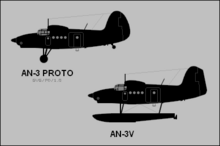Antonov An-3
This article needs to be updated. (April 2023) |
| An-3 | |
|---|---|

| |
| Antonov An-3T of MChS Rossii in June 2007.
| |
| Role | utility aircraft |
| Manufacturer | Antonov |
| Built by | Production Corporation Polyot (2000–2009) |
| First flight | 13 May 1980 |
| Introduction | 21 November 2000 |
| Status | In service |
| Primary user | regional and private operators |
| Produced | 2000–2009 (in Russia) Ukraine (since 2012) |
| Number built | 25 |
| Developed from | Antonov An-2 |
The Antonov An-3 is a Soviet (later Ukrainian and Russian) civil multipurpose and agricultural aircraft. It is essentially a turboprop-powered development of the An-2, designed to upgrade or replace it. The basic transport version (An-3T) is supplemented by a cargo/passenger version (An-3TK), an agricultural version (An-3SH), a forest fire-fighting version (An-3P), as well as an ambulance version.[1][2] It is designed to carry passengers and cargo, operating from paved or unpaved airfields, including snow covered surfaces up to 35 cm (14 in) deep (using a ski landing gear).[3]
Upgrading
The upgrading consisted of replacement of the
The first example flew as early as May 13, 1980, but because of a lack of official interest in the project, work proceeded very slowly. Flight testing was not complete until 1991. It is one of the few turbine-powered biplane designs to date. The An-3T received its Type Certificate on 31 August 2000. Supplements to the Type Certificate included version with ski landing gear and an agricultural version.[2]
Variants
The project was revitalised in the late 1990s when it was taken over by Polyot State Aerospace Enterprise, and a marketing campaign began in earnest in 2000, although sales have been limited. It is available in four forms, the basic transport version (An-3T), the convertible cargo/passenger able to carry 12 passengers or 1,800 kg (4,000 lb) of cargo (An-3TK)k the agricultural aircraft (An-3SH—"Selsko-Khosiajstwenni") and the fire-fighting version (An-3P).[2]
Another attempt to replace the An-2 on Soviet farms was made in the 1970s with the
From 2007, the "Polyot" Production Association started to upgrade the first ten An-2s of the
Specifications (An-3T)


Data from Antonov An-2[6]
General characteristics
- Crew: two
- Capacity: Useful load 1,800 kg (4,000 lb)
- Length: 14 m (45 ft 11 in)
- Wingspan: 18.176 m (59 ft 8 in)
- Height: 4.235 m (13 ft 11 in)
- Wing area: 71.51 m2 (769.7 sq ft)
- Max takeoff weight: 5,800 kg (12,787 lb)
- Powerplant: 1 × Glushenkov TVD-20-03 Turboprop, 1,010 kW (1,350 hp)
Performance
- Maximum speed: 260 km/h (160 mph, 140 kn)
- Cruise speed: 220 km/h (140 mph, 120 kn) at 2,000 m (6,600 ft)
- Range: 550 km (340 mi, 300 nmi) with a 1,500 kg (3,300 lb) payload
- Service ceiling: 4,400 m (14,400 ft)
- Rate of climb: 5 m/s (980 ft/min)
- Wing loading: 81 kg/m2 (17 lb/sq ft)
- Power/mass: 0.174 kW/kg
See also
Related development
- Antonov An-2
- Antonov An-4
- Antonov An-6
Aircraft of comparable role, configuration, and era
References
- ^ a b Antonov 3 (1998), Antonov Scientific/Technical Complex, specification card
- ^ a b c d Antonov-3 Family (2002), Antonov Scientific/Technical Complex, specification card
- ^ a b An-3 Light Multipurpose Aircraft, Antonov Aeronautical Scientific/Technical Complex, news release. n.d.
- ^ Military Parade 4-2007, page 33.
- ^ "AVIA - Associazione di Volontariato in Italia per l'Aviazione". Archived from the original on 2011-10-06. Retrieved 2011-08-25.
- ISBN 1-85780-162-8.
- Самолет АН-3. Russian Weapons and Military Technologies (in Russian). CompActive Ltd. Archived from the original on 26 May 2006. Retrieved 2006-07-01. (Shortened version in English available here)
